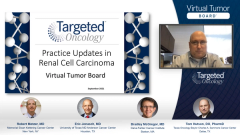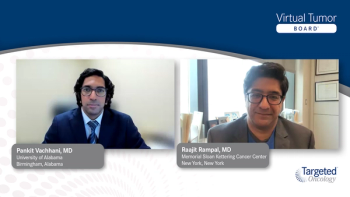
Case 3: Multidisciplinary Team Engagement in RCC
The expert panel discusses the role of multidisciplinary teams in treatment of patients with RCC.
Episodes in this series

Robert Motzer, MD: Let’s move on with this patient and hear about how he was treated.
Bradley McGregor, MD: The patient had a multidisciplinary evaluation and after extensive discussion, it was felt that he could undergo successful surgery without need for preoperative therapy. He underwent left nephrectomy, and final pathology, as you can see here, with lymph node dissection actually showed no lymph nodes involved, negative margins. It was a Fuhrman grade 3 clear cell carcinoma, T3 with no sarcomatoid features.
Robert Motzer, MD: Is this, in terms of this patient’s having his disease completely refracted, would he be considered at low risk for recurrence or high risk for recurrence? And how would you make that determination?
Bradley McGregor, MD: I would consider him at high risk for recurrence. He had a pathological T3, high-grade disease. Thus, certainly I would be worried about his risk of recurrence in the upcoming 2 to 5 years.
Robert Motzer, MD: The standard of care is surveillance for people with locally advanced renal cell carcinoma, based on the lack of data suggesting systemic therapy played a role. Now, Tom, you’ve been involved in this field back through the early days of sunitinib, and at the time when sunitinib and the other TKIs [tyrosine kinase inhibitors] showed promise in patients with metastatic disease, I think we all had high hopes that they would pan out in the adjuvant setting. What’s your feeling in terms of TKI adjuvant therapy, and if sunitinib is approved, is that something that you’ve been using? Where do you go with the TKIs as an adjuvant therapy?
Tom Hutson, DO, PharmD: Yes. I think in 2021, it’s difficult and challenging to want to give sunitinib in the adjuvant setting. There was some excitement when the 1 positive trial that we had was there and maybe some of the other agents, adjuvant trials were not yet available, that we may be on to something. But the reality is in my experience of the handful of folks I’ve offered adjuvant sunitinib to and who have taken it, is it’s mirrored the clinical trial experience where patients are unable to take it for very long at all.
There’s really a very modest benefit in patients who are able to take sunitinib. The whole mechanism of how that would work has always been somewhat concerning to me because micrometastatic disease generally is not a disease that is relying upon, I would think, angiogenesis as its strategy to survive. Thus, I’ve always wondered with micrometastatic disease, how well a TKI, which is really not affecting the tumor itself, it’s the microenvironment, would work. It’s not unsurprising, although we hoped, but not unsurprising that there was minimal benefit. Thus, I don’t see that its use is supported wide scale. You can certainly mention it to patients there, but beyond that it’s hard to encourage patients to go down that route.
Robert Motzer, MD: There has been a high level of promise with regard to I-O [immune-oncology] therapy in early stage disease. I know Eric, at MD Anderson [Cancer Center], your group has really led the way with a neoadjuvant approach in terms of IPI/NIVO [ipilimumab/nivolumab] or I-O therapy. From your standpoint, what’s the particular interest or promise in terms of using I-O therapy in localized early stage disease rather than in later lines of therapy? Is there any rationale, is there a biologic rationale?
Eric Jonasch, MD: Yes. There are 2 ways to think about this, and there have been some clinical trials that have really taken advantage of these thought processes. When the primary tumor is in place, you may want to train the immune system to understand which tumor antigens the T cells need to go against, which gives you a rationale for a neoadjuvant strategy.
Concerning an adjuvant strategy, if you have micrometastatic disease after resection, and you then get the immune system to be stimulated to eradicate those micrometastases, once again, I think there’s a solid mechanistic rationale for using this type of approach. I echo what Tom was saying. With TKI therapy in the adjuvant setting, it’s like what vasculature are you trying to actually target? There isn’t really one in the micrometastasis for a certain period of time. It makes a lot more mechanistic sense to actually use PD-1 blocking agents, or PD-L1 blocking agents for that matter, in the neoadjuvant or adjuvant setting.
Transcript edited for clarity.








































